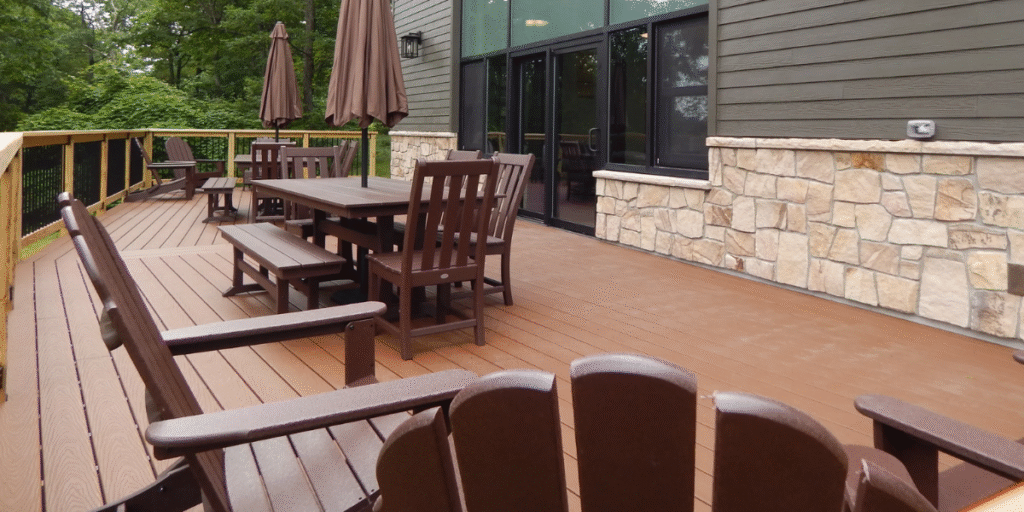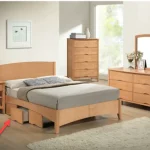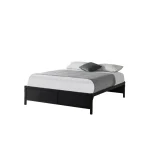Is The Furniture ADA-Compliant?

It’s essential to create environments that are both accessible and inclusive, as this is a legal requirement and a professional obligation. In behavioral healthcare, residential, and human services settings, accessibility allows every individual, including those with disabilities, mobility challenges, or those in recovery, to participate in daily activities and care programs. There is no official label for ADA-compliant furniture, but each piece must fit within spaces built according to ADA furniture standards. This article explains how furniture contributes to accessibility, outlines the key ADA furniture standards, and describes how organizations can apply these principles to build functional, inclusive environments.
Understanding ADA Compliance and Furniture

Before discussing specific standards, it is helpful to understand how ADA compliance relates to furniture and space design. The Americans with Disabilities Act sets requirements that make public and shared environments accessible to all individuals. While furniture itself is not certified as ADA-compliant furniture, its design, placement, and usability should contribute to accessibility and comfort for everyone who uses the space.
ADA Regulations vs. Movable Furniture
ADA regulations apply primarily to fixed or built-in components such as counters, service desks, and permanently installed tables. Movable furniture, however, still influences how accessible a space feels and functions. A room may appear well-designed, but if chairs, desks, and tables are too close together or too tall, accessibility becomes limited. ADA furniture standards, therefore, guide how movable pieces fit within the environment.
Behavioral healthcare and group home facilities often rely on modular and movable furniture to create flexible layouts. Selecting ADA-compliant furniture with proper height and clearance measurements supports safe, adaptable, and inclusive spaces for everyone.
What Is Considered ADA Compliant?
ADA compliance focuses on usability and equal access. In furniture planning, this means providing enough room for movement, appropriate surface heights for wheelchair users, and hardware that operates easily. Spaces arranged according to ADA furniture standards are considered:
- Spatial clearance around each furniture item.
- Ease of use for people with varied physical abilities.
- Reach ranges that allow shelves, controls, and surfaces to be accessible.
These principles help individuals use furniture confidently and independently.
Key ADA Standards for Furniture
Understanding key ADA dimensions and spatial requirements helps organizations make informed furniture decisions. Whether selecting an ADA-compliant desk, ADA-compliant table, or accessible seating, these guidelines form the foundation of an inclusive environment.
Tables, Desks, and Counters
Tables and desks serve as focal points in administrative and care spaces. ADA furniture standards specify the following dimensions:
- Surface height: The surface of a desk or table should be between 28 and 34 inches from the floor, offering a suitable reach for people seated in wheelchairs.
- Knee clearance: Provide at least 27 inches of vertical space beneath the surface so wheelchair users can pull in closely and sit comfortably without obstruction.
- Depth of clearance: A minimum of 19 inches of depth allows adequate room for legs and knees, promoting a natural sitting position.
- Width: Leave at least 30 inches of clear floor space so wheelchair users can approach, position, and use the table freely.
These measurements define an ADA-compliant desk or ADA-compliant table. Adhering to these standards allows wheelchair users to sit and work without restriction. In dining, therapy, or office environments, such tables encourage interaction and inclusion.
Seating Requirements
Seating plays a crucial role in accessibility. ADA seating requirements establish clear expectations for space, placement, and usability:
- Clear space: It’s important that every wheelchair spot has a clear floor space measuring at least 30 by 48 inches. This ensures that users have enough room to move around and sit comfortably next to furniture.
- Dispersion: Accessible seating should be spread throughout a space, allowing individuals using wheelchairs to select their preferred location and engage equally with others.
- Usability: Furniture should function smoothly without requiring excessive strength or fine motor skills, supporting independence.
- Companion seating: Each wheelchair space should include at least one companion seat so individuals can sit next to friends, family members, or caregivers.
These guidelines apply to waiting rooms, dining areas, therapy rooms, and outdoor environments. When facilities include ADA-compliant chairs and arrange them thoughtfully, clients experience inclusion and respect in shared spaces.
Shelving and Storage
Storage and shelving units must be accessible for everyone. ADA furniture standards recommend the following:
- Forward reach: Items should be positioned between 15 and 48 inches from the floor.
- Side reach: The maximum reach should not exceed 54 inches.
- Accessible lockers: At least 5% of lockers or storage units should be fully accessible, with handles or latches that are easy to grasp.
These measurements allow staff and clients in care settings to reach items safely and comfortably.
Paths of Travel
Clear travel paths help people navigate with ease. The ADA specifies:
- Aisle width: At least 36 inches for continuous movement through a space.
- Turning radius: A minimum 60-inch diameter for wheelchairs.
Keeping pathways clear around ADA-compliant furniture supports smooth navigation and reduces the risk of accidents in therapy areas, dining halls, and shared living environments.
Applying ADA Standards to Behavioral Healthcare and Human Services Facilities

Integrating ADA furniture standards into healthcare and human services spaces requires a focus on accessibility, layout, and practicality. Accessibility should be part of facility planning from the start to create spaces that support both clients and staff.
Reviewing Current Spaces for Accessibility
An internal review helps identify areas that need improvement. Facility managers can:
- Space Measurement: Measure clearances around desks, chairs, and tables. Assess whether there is enough space for wheelchair users or those using mobility aids to move freely and reach all necessary areas.
- Furniture Evaluation: Confirm that ADA-compliant furniture meets required height and reach standards. Evaluate desks, tables, and seating to verify they provide easy access and usability for all individuals.
- Pathway Review: Review circulation paths for adequate aisle width and turning space. Check that hallways and open areas meet ADA requirements to allow safe, comfortable movement.
This process supports continuous improvement and maintains a consistent level of accessibility across the facility.
Integrating Accessible Furniture into Facility Design
When selecting ADA-compliant furniture, planners should focus on how placement affects usability and flow. To maintain accessibility:
- Use adjustable-height desks and tables whenever possible to accommodate different users.
- Choose ADA-compliant chairs that are stable and simple to move.
- Keep pathways open and free from obstruction.
- Collaborate with designers or accessibility specialists familiar with ADA furniture standards to maintain compliance.
Applying these practices from the beginning helps organizations avoid layout issues and create spaces that serve every individual effectively.
ADA-Compliant Furniture in Practice
Accessibility becomes meaningful when it influences real-world environments. Applying ADA furniture standards in daily operations promotes functionality for clients, staff, and visitors alike.
Common Areas and Dining Spaces

Dining and social areas bring people together for meals and group activities. ADA-compliant tables and ADA-compliant chairs should be arranged to allow wheelchair users to sit among others comfortably. To maintain accessibility:
- Table Clearance: Leave at least 36 inches of open space between table edges and walls to allow people using wheelchairs to move freely.
- Open-Base Tables: Use tables with open bases so wheelchairs can slide underneath, allowing users to position themselves easily and participate naturally in activities.
- Seating Distribution: Distribute accessible seating evenly so everyone can choose where to sit and interact.
Following ADA seating requirements in these spaces promotes participation and equality.
Administrative and Counseling Offices
Offices and counseling rooms should serve both staff and clients. Desks that meet ADA furniture standards allow accessibility for wheelchair users and others who need additional space. Features of an ADA-compliant desk include:
- Adjustable surface height options.
- A minimum knee clearance of 27 inches.
- Enough clear floor space for comfortable wheelchair positioning.
Adhering to these guidelines supports productivity and accessibility in administrative areas.
Outdoor and Recreational Areas

Accessibility should extend outdoors. ADA outdoor furniture, such as benches, picnic tables, and seating areas, must follow ADA guidelines. Important considerations include:
- Surface stability: Surfaces should be smooth and non-slip to improve mobility and safety.
- Appropriate height: Table heights should fall between 28 and 34 inches for comfortable use by all visitors.
- Adequate clearance: Outdoor furniture should have enough open space for wheelchair turning and positioning.
Outdoor areas furnished with ADA-compliant furniture encourage participation in therapy, recreation, and social interaction for all individuals.
Benefits of ADA-Compliant Environments
ADA compliance enhances both experience and organizational performance. Environments that feature ADA-compliant furniture and accessible layouts promote independence and equality for all users.
Enhancing Client Participation
When layouts follow ADA furniture standards, individuals gain confidence in navigating and engaging in daily activities. Accessible furniture supports participation in therapy sessions, dining, and group interactions. Meeting ADA seating requirements allows clients to take part comfortably and inclusively.
Demonstrating Professional and Ethical Commitment
Selecting ADA-compliant furniture represents a strong commitment to inclusion and professional ethics. It conveys respect for clients and reflects the values of behavioral health and human service organizations. Attention to ADA furniture standards reinforces trust and dedication to equitable care.
Our Commitment to Accessibility at Furniture Concepts

At Furniture Concepts, accessibility begins with offering the right products and dependable support. As a trusted wholesaler, we provide behavioral healthcare and human services organizations with ADA-compliant furniture that meets quality and function standards. From ADA-compliant desks and tables to ADA-compliant chairs, each product aligns with ADA furniture standards to promote accessibility in professional care settings.
We collaborate with facility managers, purchasing teams, and organizational leaders to:
- Product Guidance: Recommend furniture that aligns with ADA requirements and supports accessibility goals in care environments.
- Space Assessment: Assist teams in evaluating furniture dimensions and layout compatibility to maintain accessible pathways and usable clearances.
- Practical Solutions: Offer product options that balance durability, usability, and suitability for a wide range of behavioral health and residential needs.
Our mission is to deliver reliable, inclusive furnishings that support engagement, dignity, and accessibility across every environment.
Conclusion
Furniture may not carry an official ADA-compliant furniture label, but its design and placement should meet ADA furniture standards to promote accessibility. Regular reviews of clearances, dimensions, and travel paths help maintain spaces that are functional and inclusive. ADA compliance encourages accessibility, equality, and respect in every setting.
Organizations that invest in ADA-compliant furniture create environments that reflect care and inclusion, qualities essential to behavioral healthcare and human service success.Ready to elevate your space? Partner with Furniture Concepts today to build environments that align with ADA standards and support accessibility for all individuals.

















